Westward Expansion: Analyzing the Impact of Railroads (1860-1890)
VerifiedAdded on 2022/12/19
|5
|1085
|56
Essay
AI Summary
This essay explores the critical role of railroad expansion in the context of America's Westward Expansion, particularly between 1860 and 1890. It begins by outlining the historical backdrop of westward movement, triggered by factors like population growth and the concept of Manifest Destiny, which fueled the need for new lands. The essay then examines how railroad development and westward expansion were interconnected, with settlers moving west creating a demand for better transportation, leading to the construction of railroads, which, in turn, facilitated further settlement and agricultural development. By analyzing the population and agricultural growth in regions connected by the railroads, the paper concludes that railroads significantly contributed to the industrial revolution, mining, mailing systems, and overall economic growth of America.
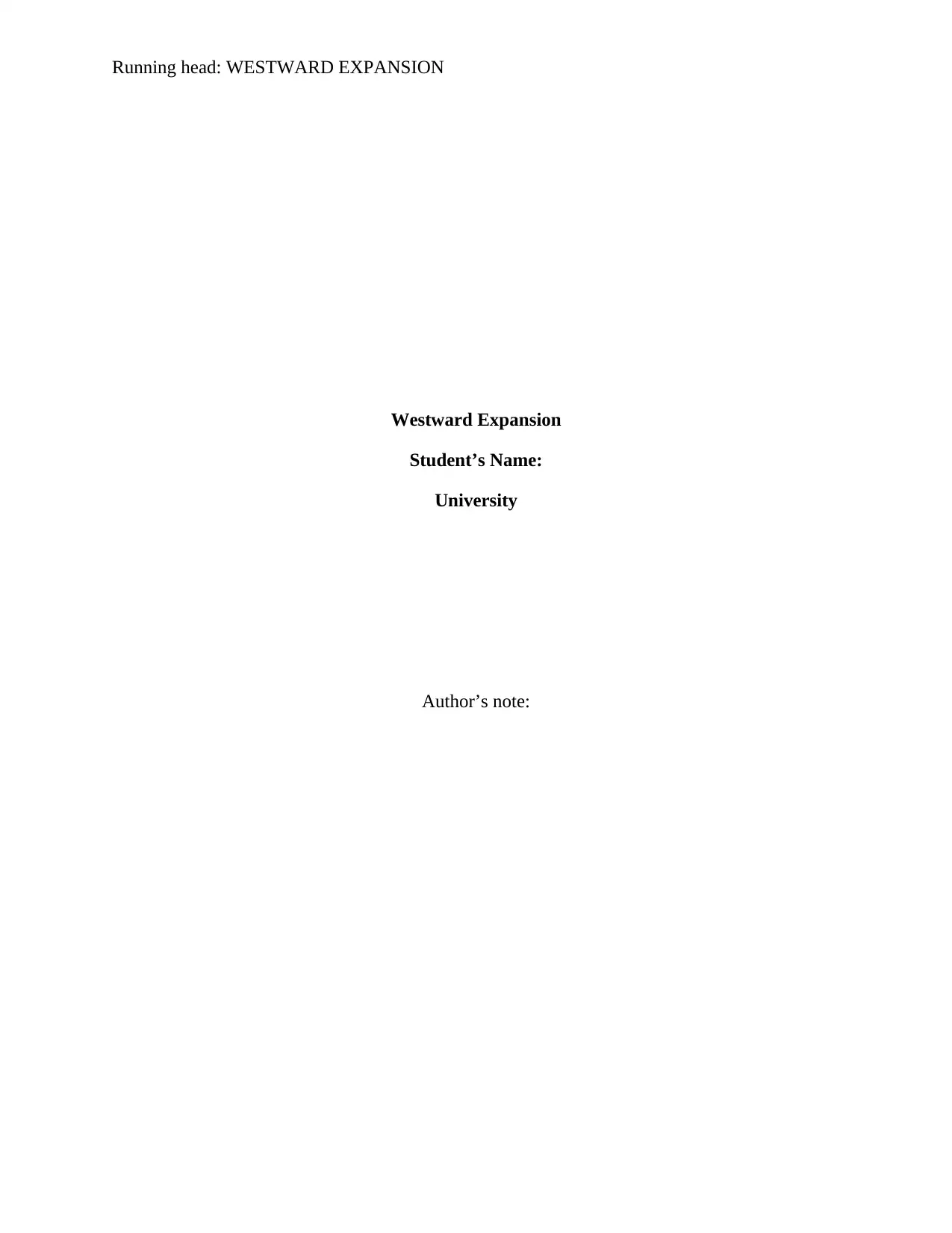
Running head: WESTWARD EXPANSION
Westward Expansion
Student’s Name:
University
Author’s note:
Westward Expansion
Student’s Name:
University
Author’s note:
Paraphrase This Document
Need a fresh take? Get an instant paraphrase of this document with our AI Paraphraser
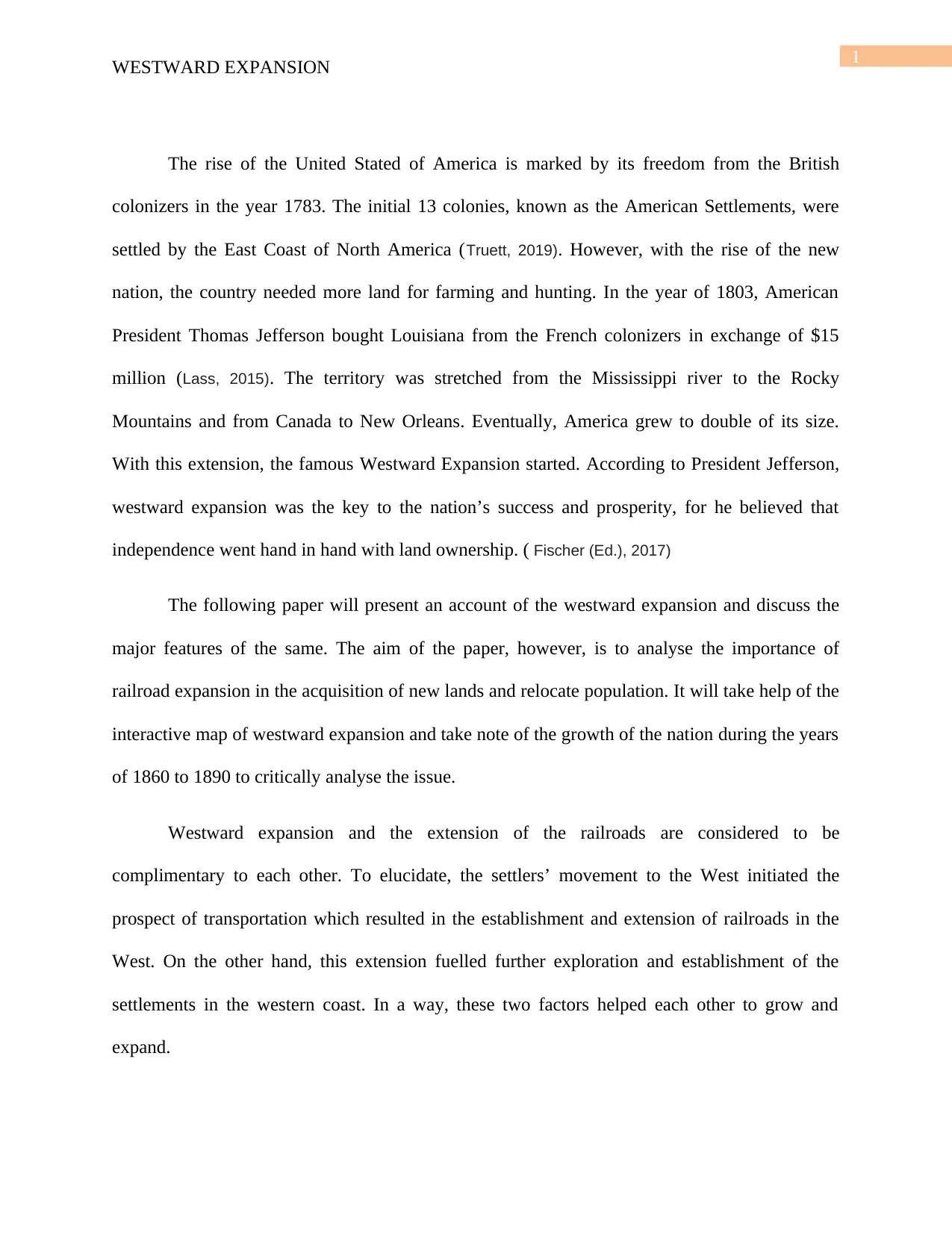
1
WESTWARD EXPANSION
The rise of the United Stated of America is marked by its freedom from the British
colonizers in the year 1783. The initial 13 colonies, known as the American Settlements, were
settled by the East Coast of North America (Truett, 2019). However, with the rise of the new
nation, the country needed more land for farming and hunting. In the year of 1803, American
President Thomas Jefferson bought Louisiana from the French colonizers in exchange of $15
million (Lass, 2015). The territory was stretched from the Mississippi river to the Rocky
Mountains and from Canada to New Orleans. Eventually, America grew to double of its size.
With this extension, the famous Westward Expansion started. According to President Jefferson,
westward expansion was the key to the nation’s success and prosperity, for he believed that
independence went hand in hand with land ownership. ( Fischer (Ed.), 2017)
The following paper will present an account of the westward expansion and discuss the
major features of the same. The aim of the paper, however, is to analyse the importance of
railroad expansion in the acquisition of new lands and relocate population. It will take help of the
interactive map of westward expansion and take note of the growth of the nation during the years
of 1860 to 1890 to critically analyse the issue.
Westward expansion and the extension of the railroads are considered to be
complimentary to each other. To elucidate, the settlers’ movement to the West initiated the
prospect of transportation which resulted in the establishment and extension of railroads in the
West. On the other hand, this extension fuelled further exploration and establishment of the
settlements in the western coast. In a way, these two factors helped each other to grow and
expand.
WESTWARD EXPANSION
The rise of the United Stated of America is marked by its freedom from the British
colonizers in the year 1783. The initial 13 colonies, known as the American Settlements, were
settled by the East Coast of North America (Truett, 2019). However, with the rise of the new
nation, the country needed more land for farming and hunting. In the year of 1803, American
President Thomas Jefferson bought Louisiana from the French colonizers in exchange of $15
million (Lass, 2015). The territory was stretched from the Mississippi river to the Rocky
Mountains and from Canada to New Orleans. Eventually, America grew to double of its size.
With this extension, the famous Westward Expansion started. According to President Jefferson,
westward expansion was the key to the nation’s success and prosperity, for he believed that
independence went hand in hand with land ownership. ( Fischer (Ed.), 2017)
The following paper will present an account of the westward expansion and discuss the
major features of the same. The aim of the paper, however, is to analyse the importance of
railroad expansion in the acquisition of new lands and relocate population. It will take help of the
interactive map of westward expansion and take note of the growth of the nation during the years
of 1860 to 1890 to critically analyse the issue.
Westward expansion and the extension of the railroads are considered to be
complimentary to each other. To elucidate, the settlers’ movement to the West initiated the
prospect of transportation which resulted in the establishment and extension of railroads in the
West. On the other hand, this extension fuelled further exploration and establishment of the
settlements in the western coast. In a way, these two factors helped each other to grow and
expand.
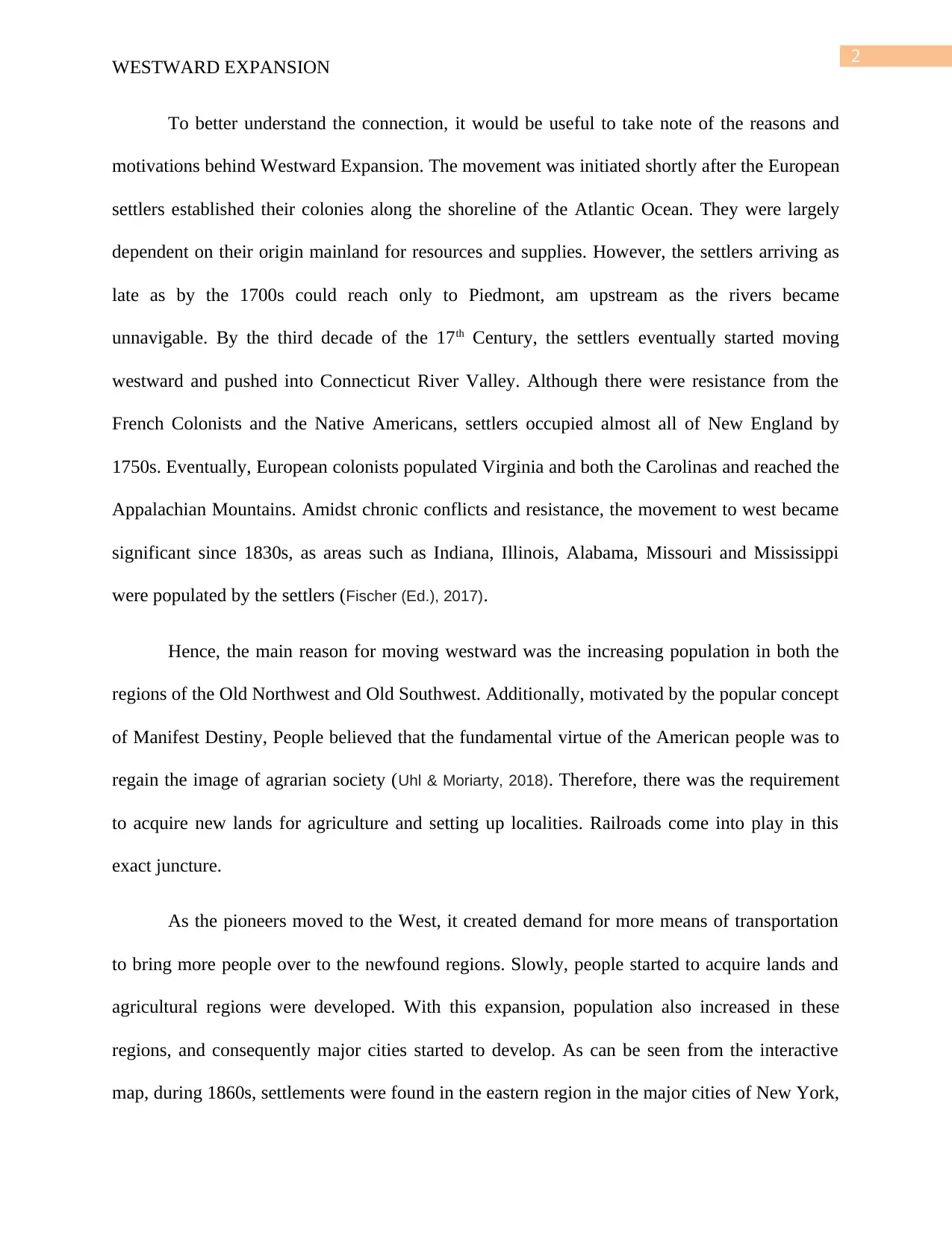
2
WESTWARD EXPANSION
To better understand the connection, it would be useful to take note of the reasons and
motivations behind Westward Expansion. The movement was initiated shortly after the European
settlers established their colonies along the shoreline of the Atlantic Ocean. They were largely
dependent on their origin mainland for resources and supplies. However, the settlers arriving as
late as by the 1700s could reach only to Piedmont, am upstream as the rivers became
unnavigable. By the third decade of the 17th Century, the settlers eventually started moving
westward and pushed into Connecticut River Valley. Although there were resistance from the
French Colonists and the Native Americans, settlers occupied almost all of New England by
1750s. Eventually, European colonists populated Virginia and both the Carolinas and reached the
Appalachian Mountains. Amidst chronic conflicts and resistance, the movement to west became
significant since 1830s, as areas such as Indiana, Illinois, Alabama, Missouri and Mississippi
were populated by the settlers (Fischer (Ed.), 2017).
Hence, the main reason for moving westward was the increasing population in both the
regions of the Old Northwest and Old Southwest. Additionally, motivated by the popular concept
of Manifest Destiny, People believed that the fundamental virtue of the American people was to
regain the image of agrarian society (Uhl & Moriarty, 2018). Therefore, there was the requirement
to acquire new lands for agriculture and setting up localities. Railroads come into play in this
exact juncture.
As the pioneers moved to the West, it created demand for more means of transportation
to bring more people over to the newfound regions. Slowly, people started to acquire lands and
agricultural regions were developed. With this expansion, population also increased in these
regions, and consequently major cities started to develop. As can be seen from the interactive
map, during 1860s, settlements were found in the eastern region in the major cities of New York,
WESTWARD EXPANSION
To better understand the connection, it would be useful to take note of the reasons and
motivations behind Westward Expansion. The movement was initiated shortly after the European
settlers established their colonies along the shoreline of the Atlantic Ocean. They were largely
dependent on their origin mainland for resources and supplies. However, the settlers arriving as
late as by the 1700s could reach only to Piedmont, am upstream as the rivers became
unnavigable. By the third decade of the 17th Century, the settlers eventually started moving
westward and pushed into Connecticut River Valley. Although there were resistance from the
French Colonists and the Native Americans, settlers occupied almost all of New England by
1750s. Eventually, European colonists populated Virginia and both the Carolinas and reached the
Appalachian Mountains. Amidst chronic conflicts and resistance, the movement to west became
significant since 1830s, as areas such as Indiana, Illinois, Alabama, Missouri and Mississippi
were populated by the settlers (Fischer (Ed.), 2017).
Hence, the main reason for moving westward was the increasing population in both the
regions of the Old Northwest and Old Southwest. Additionally, motivated by the popular concept
of Manifest Destiny, People believed that the fundamental virtue of the American people was to
regain the image of agrarian society (Uhl & Moriarty, 2018). Therefore, there was the requirement
to acquire new lands for agriculture and setting up localities. Railroads come into play in this
exact juncture.
As the pioneers moved to the West, it created demand for more means of transportation
to bring more people over to the newfound regions. Slowly, people started to acquire lands and
agricultural regions were developed. With this expansion, population also increased in these
regions, and consequently major cities started to develop. As can be seen from the interactive
map, during 1860s, settlements were found in the eastern region in the major cities of New York,
⊘ This is a preview!⊘
Do you want full access?
Subscribe today to unlock all pages.

Trusted by 1+ million students worldwide
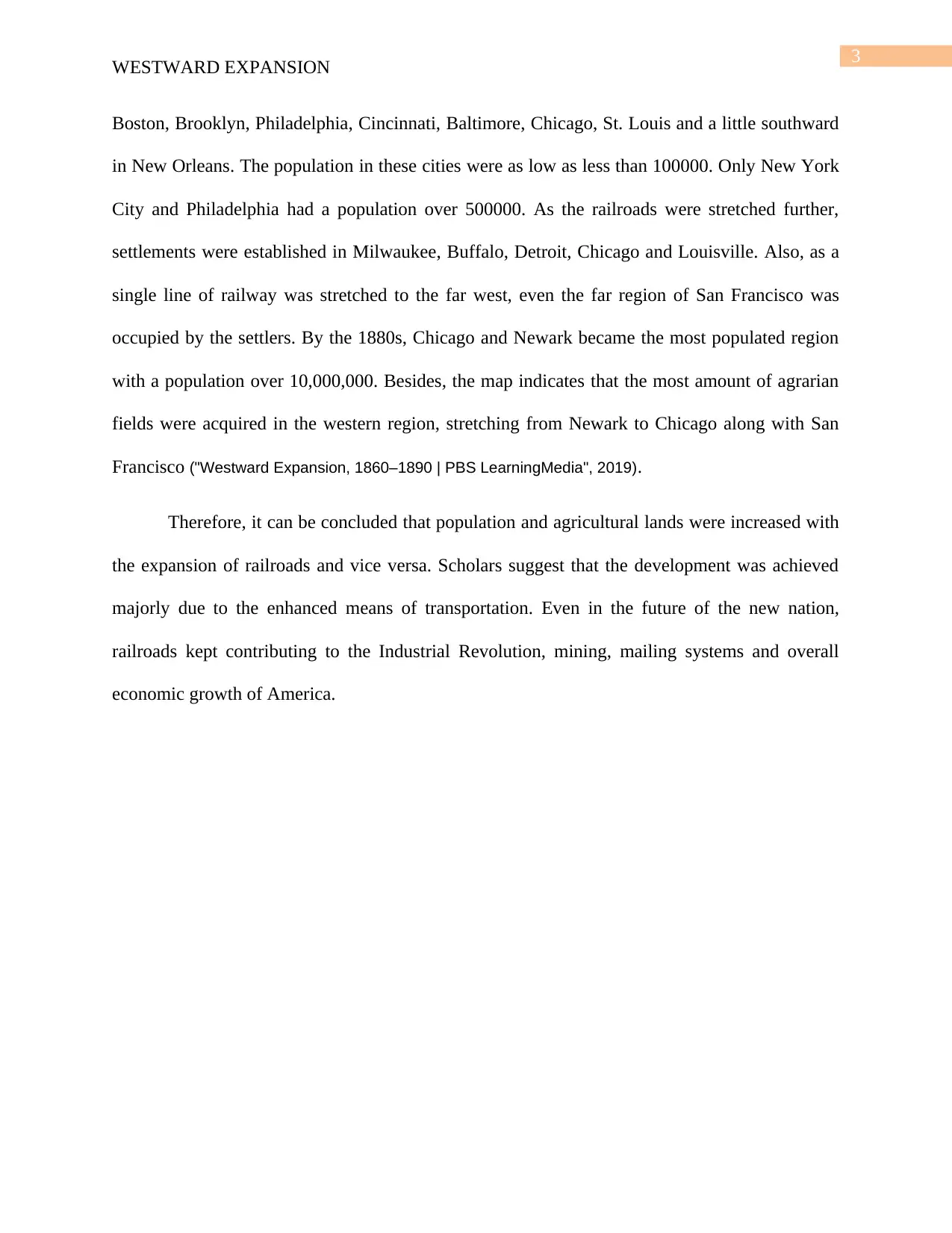
3
WESTWARD EXPANSION
Boston, Brooklyn, Philadelphia, Cincinnati, Baltimore, Chicago, St. Louis and a little southward
in New Orleans. The population in these cities were as low as less than 100000. Only New York
City and Philadelphia had a population over 500000. As the railroads were stretched further,
settlements were established in Milwaukee, Buffalo, Detroit, Chicago and Louisville. Also, as a
single line of railway was stretched to the far west, even the far region of San Francisco was
occupied by the settlers. By the 1880s, Chicago and Newark became the most populated region
with a population over 10,000,000. Besides, the map indicates that the most amount of agrarian
fields were acquired in the western region, stretching from Newark to Chicago along with San
Francisco ("Westward Expansion, 1860–1890 | PBS LearningMedia", 2019).
Therefore, it can be concluded that population and agricultural lands were increased with
the expansion of railroads and vice versa. Scholars suggest that the development was achieved
majorly due to the enhanced means of transportation. Even in the future of the new nation,
railroads kept contributing to the Industrial Revolution, mining, mailing systems and overall
economic growth of America.
WESTWARD EXPANSION
Boston, Brooklyn, Philadelphia, Cincinnati, Baltimore, Chicago, St. Louis and a little southward
in New Orleans. The population in these cities were as low as less than 100000. Only New York
City and Philadelphia had a population over 500000. As the railroads were stretched further,
settlements were established in Milwaukee, Buffalo, Detroit, Chicago and Louisville. Also, as a
single line of railway was stretched to the far west, even the far region of San Francisco was
occupied by the settlers. By the 1880s, Chicago and Newark became the most populated region
with a population over 10,000,000. Besides, the map indicates that the most amount of agrarian
fields were acquired in the western region, stretching from Newark to Chicago along with San
Francisco ("Westward Expansion, 1860–1890 | PBS LearningMedia", 2019).
Therefore, it can be concluded that population and agricultural lands were increased with
the expansion of railroads and vice versa. Scholars suggest that the development was achieved
majorly due to the enhanced means of transportation. Even in the future of the new nation,
railroads kept contributing to the Industrial Revolution, mining, mailing systems and overall
economic growth of America.
Paraphrase This Document
Need a fresh take? Get an instant paraphrase of this document with our AI Paraphraser
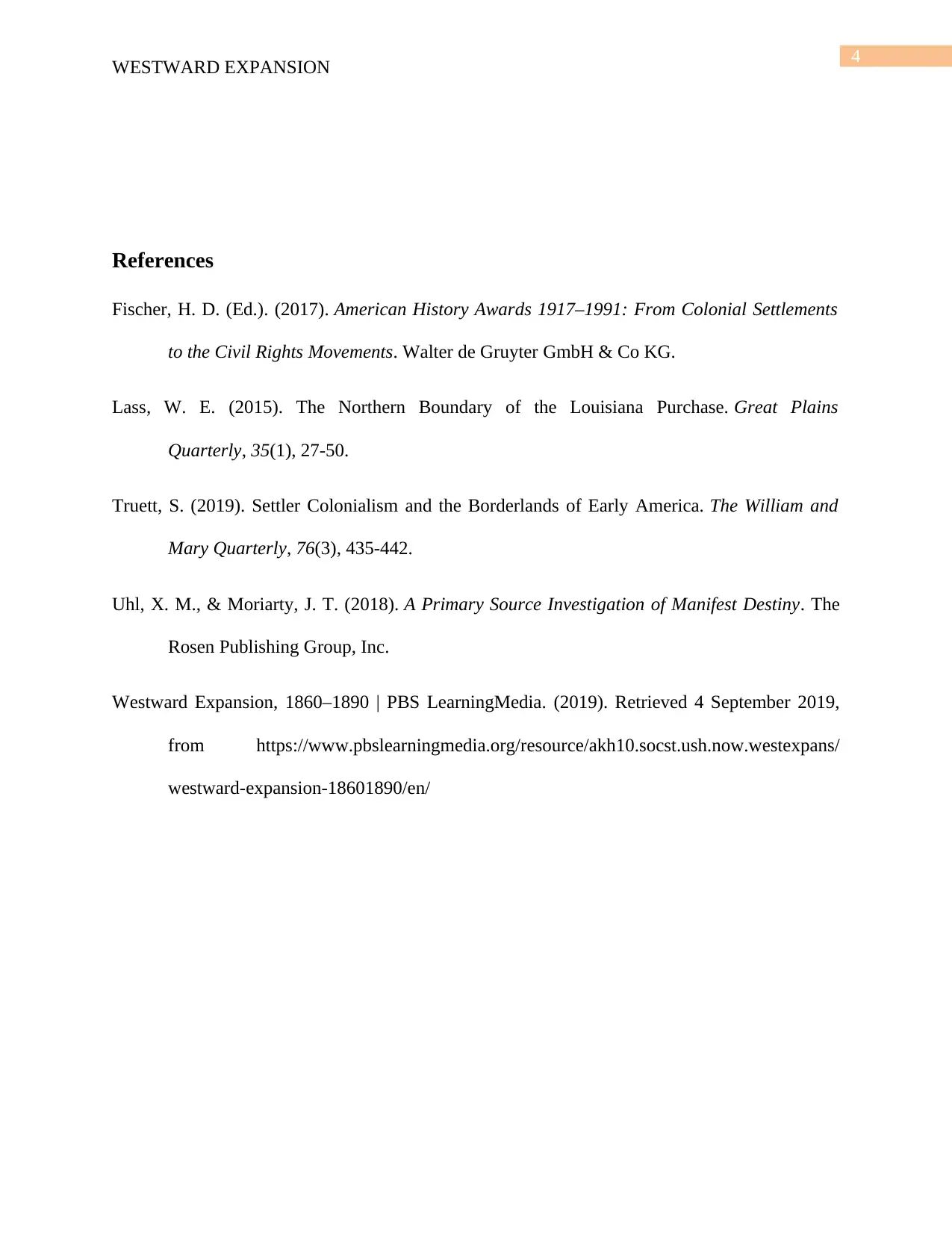
4
WESTWARD EXPANSION
References
Fischer, H. D. (Ed.). (2017). American History Awards 1917–1991: From Colonial Settlements
to the Civil Rights Movements. Walter de Gruyter GmbH & Co KG.
Lass, W. E. (2015). The Northern Boundary of the Louisiana Purchase. Great Plains
Quarterly, 35(1), 27-50.
Truett, S. (2019). Settler Colonialism and the Borderlands of Early America. The William and
Mary Quarterly, 76(3), 435-442.
Uhl, X. M., & Moriarty, J. T. (2018). A Primary Source Investigation of Manifest Destiny. The
Rosen Publishing Group, Inc.
Westward Expansion, 1860–1890 | PBS LearningMedia. (2019). Retrieved 4 September 2019,
from https://www.pbslearningmedia.org/resource/akh10.socst.ush.now.westexpans/
westward-expansion-18601890/en/
WESTWARD EXPANSION
References
Fischer, H. D. (Ed.). (2017). American History Awards 1917–1991: From Colonial Settlements
to the Civil Rights Movements. Walter de Gruyter GmbH & Co KG.
Lass, W. E. (2015). The Northern Boundary of the Louisiana Purchase. Great Plains
Quarterly, 35(1), 27-50.
Truett, S. (2019). Settler Colonialism and the Borderlands of Early America. The William and
Mary Quarterly, 76(3), 435-442.
Uhl, X. M., & Moriarty, J. T. (2018). A Primary Source Investigation of Manifest Destiny. The
Rosen Publishing Group, Inc.
Westward Expansion, 1860–1890 | PBS LearningMedia. (2019). Retrieved 4 September 2019,
from https://www.pbslearningmedia.org/resource/akh10.socst.ush.now.westexpans/
westward-expansion-18601890/en/
1 out of 5
Your All-in-One AI-Powered Toolkit for Academic Success.
+13062052269
info@desklib.com
Available 24*7 on WhatsApp / Email
![[object Object]](/_next/static/media/star-bottom.7253800d.svg)
Unlock your academic potential
Copyright © 2020–2025 A2Z Services. All Rights Reserved. Developed and managed by ZUCOL.

